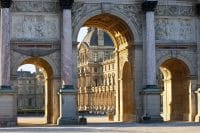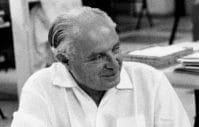
Rococo Style: How it Distincts in Architecture, Furnishings and Painting
Rococo Style: Birth and Development The Rococo, as a reflection of the trends, tastes and way of life of France…
Luigi and Angiolo Falcini (Campi, 1794 – Florence, 1861) and (Campi, 1801 – Florence, 1850)
Mechanical desk, 1835 – 1855
veneered in ebony and inlaid with woods of various colors, ivory and mother-of-pearl, 86,5×98,5 cm
Accompanied by the attribution sheet of Professor Enrico Colle shown below:
The desk, conceived as a round center table supported by four legs joined together at the bottom by crosspieces that form a platform, has all wooden surfaces veneered with ebony and covered with floral inlays made of woods of various colors. On the surface, this naturalistic decoration follows the circular pattern and is enriched with spirals of acanthus leaves, birds, small garlands and four roundels with inserted figures of knights alternating with ladies in Renaissance dresses. The Panciatichi coat of arms combined with that of the Ximenes of Aragon placed in the center of the surface completes the entire decoration, whose neo-baroque taste is dissolved in the compositional rigor typical of Neoclassicism. Under the top there are some drawers, small compartments and a removable shelf covered in morocco used as a desk, equipped with a small lectern and three small drawers.
As documented by the coat of arms inserted in the center of the top, the table-desk was commissioned by the Marquis Ferdinando Panciatichi Ximenes of Aragon, born in Florence in 1813 from the marriage between Margherita Rosselmini and Leopoldo Panciatichi (1766-1818), the latter belonging to one of the richest families of the Grand Duchy of Tuscany, who in 1816 obtained by inheritance the surname, titles and vast patrimony of the Ximenes of Aragon. An art lover and collector, the Marquis was, starting from the 1840s, a leading figure within the cosmopolitan Florentine environment, taking an interest in architecture, engineering, botany and photography. A multifaceted intellectual, Ferdinando Panciatichi was also a skilled entrepreneur and politician who helped the city's most important cultural institutions with substantial donations. His collection consisted of over 500 paintings arranged, together with many furnishings, art objects and ancient weapons, in some rooms of the Borgo Pinti palace set up as a real museum where there was also a large library which was then sold in 1859 , to Grand Duke Leopold II and today preserved at the National Library of Florence. With the union of the two families, the Panciatichi and the Ximenes, Ferdinando inherited numerous residences including the Panciatichi palace, now property of the Tuscany Region, the Ximenes d'Aragona palace in Borgo Pinti (still inhabited today by his descendants), where he had arranged his Gallery, and the castle of Sammezzano which he restored, transforming it into an enormous villa in oriental style. Precisely in this vast estate the marquis retired in the last years of his life until his death on 18 October 1897, leaving his daughter Marianna as heir to his immense fortune who, in turn, passed the paternal properties to his children Ferdinando, Alessandro and Marianna of San Giorgio, not before having sold the entire collection at auction in 1892 to divide the proceeds among his heirs (E. Santacroce, Ferdinando Panciatichi Ximenes d'Aragona and his archive between public and private, in Ferdinando Panciatichi Ximenes d'Aragona Sammezzano and the Eastern Dream 1813 – 2013, edited by E. Masiello, E. Santacroce, Livorno 2014, pp. 45 - 63). The mechanical desk originally probably furnished one of the rooms of the two city buildings inhabited by Ferdinando Panciatichi and must have been used by its illustrious owner who, like the wealthiest Florentine aristocrats and collectors, had turned to the then famous inlaid furniture workshop opened in the Tuscan capital, starting from around 1834, by the brothers Luigi (Campi, 7 January 1794 – Florence, 14 June 1861) and Angiolo (Campi, 1 July 1801 – Florence, 27 September 1850) Falcini, both sons of a carpenter who he had his workshop in Campi near Florence (S. Chiarugi, Furniture workshops in Tuscany 1780 – 1900, Florence, 1994, pp. 463 – 468). The first news about the activity of the two brothers dates back to a few years later, and more precisely to 1836: on that date, in fact, only Luigi exhibited an ebony table "with decorations of chiaroscuro inlay” which was awarded a medal, thus earning the interest of Grand Duke Leopold II, who then purchased it for his apartments in the Pitti palace; followed, in 1839, by another example with a rectangular top, this time inlaid with woods of various colors, ivory and mother-of-pearl (E. Colle, The furniture of Palazzo Pitti. The second Lorraine period 1800 – 1846. The Grand Duchy of Tuscany, Florence, 2000, p. 61). Therefore, starting from the end of the 1930s, the inlays used by the Falcini family to decorate their furniture went from the more sober use of ebony and ivory to a type of floral inlay derived from the famous seventeenth-century prototypes made by Leonardo Van der Vinne for the Medici and then exhibited in the Accademia Gallery. Furthermore, they developed a sophisticated technique for dyeing and shading wood capable of accommodating the crowded compositions of flowers and leaves which from now on will be the stylistic signature of their laboratory also praised by the president of the Academy of Fine Arts. Arts Antonio Ramirez de Montalvo. They were mostly tops for tables, chests of drawers and armchairs whose surfaces, as in the case of our desk, were almost completely covered with panels inlaid with compositions which, although taking up the elaborate seventeenth-century creations, were subject to the compositional canons typical of Neoclassicism, whose tradition had also established itself during the first half of the nineteenth century through the teaching of the ornamentalists active in the Academies (E. Colle, Nineteenth-century furniture in Italy. Furnishings and interior decorations from 1815 to 1900, Milan 2007, pp. 190 – 193, n. 43). The mechanical desk examined here in fact presents a type of decoration where the floral compositions have been arranged in perfect symmetry between the spirals of acanthus leaves, the small roundels with figurines, the birds of prey and the parrots, whose plumage recalls that of the specimens inlaid by Van der Vinne on the table tops today in the Silver Museum of Palazzo Pitti. In fact, as reported by Giuseppe Del Noce (On the Risorgimento and the rapid progress of lignotarsia in Florence [...], Florence 1863, p. 85), the Falcini's inlay works differed from those of other contemporary workshops due to the richness of plants and flowers meticulously taken from the vast families of exotic and local flora (as can be seen in the inlaid garland at the center of the crosspieces of the desk that belonged to the Marquis Panciatichi) adapted to the surfaces of the furniture according to the "best ornamental models of Greek and Roman style", without neglecting the study of decorations in Raphaelesque style. A type of decoration that is also found on the top of a table recently sold at the Wannenes Auction (Genoa 22-23 September 2015, lot no. 1025) which shares with our piece of furniture the inclusion, in the rich ornamental composition, of the human figure and the balanced distribution of the acanthus leaf spirals; while the circular arrangement of the floral decorations is similar to the description of two "tables", exhibited in Florence in 1854, "composed of three concentric circular compartments, of which the first was decorated with a rich frieze of foliage mixed with animals, excellently depicted for correctness and gradation of chiaroscuro", while the second presented a "woven garland of various flowers" and the third was "entirely occupied by various congeries of naturally grouped flowers" (V. Manteri, Report on lithotarsia, xylotarsia and carving works […], Florence 1854, p. 377). Compared to most of the furnishings known to us to date from the Falcini Laboratory, the piece of furniture examined here has a sophisticated opening mechanism that transforms it from a center table to a writing desk, which denotes an in-depth knowledge on the part of the Falcinis of the models made in the major Florentine cabinet-making workshops such as Spighi's eighteenth-century one, or the more recent one of Giovanni Socci, the latter author of a famous travel desk which, when opened, thanks to elaborate devices, presented an extractable chair, a countertop for writing, a lectern and various secrets (E. Colle, The furniture of Palazzo Pitti […], op. cit., p. 102, no. 27). Awarded at various national and international exhibitions, the works of Luigi and Angiolo Falcini enjoyed great public success and, after the aforementioned purchases by the Lorraine sovereign, many illustrious people turned to the flourishing factory to purchase their works. Among these, the sources of the time mention the Duchess of Casigliano, the Countess Borghesi Del Taja, Lord Holweston, Prince Anatolio Demidoff and the eclectic Anglo-Florentine collector Frederick Stibbert.
Bibliography:
Agnellini, F Simonetti, Italian furniture of the nineteenth century, Milan 1991, p. 87;
Chiarugi, Furniture workshops in Tuscany 1780 – 1900, Florence, 1994, p. 197, fig. 250.
2022.82.26
To supplement the descriptions, the “Antichità Giglio” gallery makes available, upon request, condition reports on the state of conservation of its assets and national and international transport estimates.

Rococo Style: Birth and Development The Rococo, as a reflection of the trends, tastes and way of life of France…

The Empire style, with its magnificent fusion of majesty and grace, remains an icon of classic furnishings, exerting a timeless charm…

Giò Ponti is one of the artists who most dominated the Italian post-war period, acting as a spokesperson for important innovations in the world…
have viewed this article in the last 30 minutes.